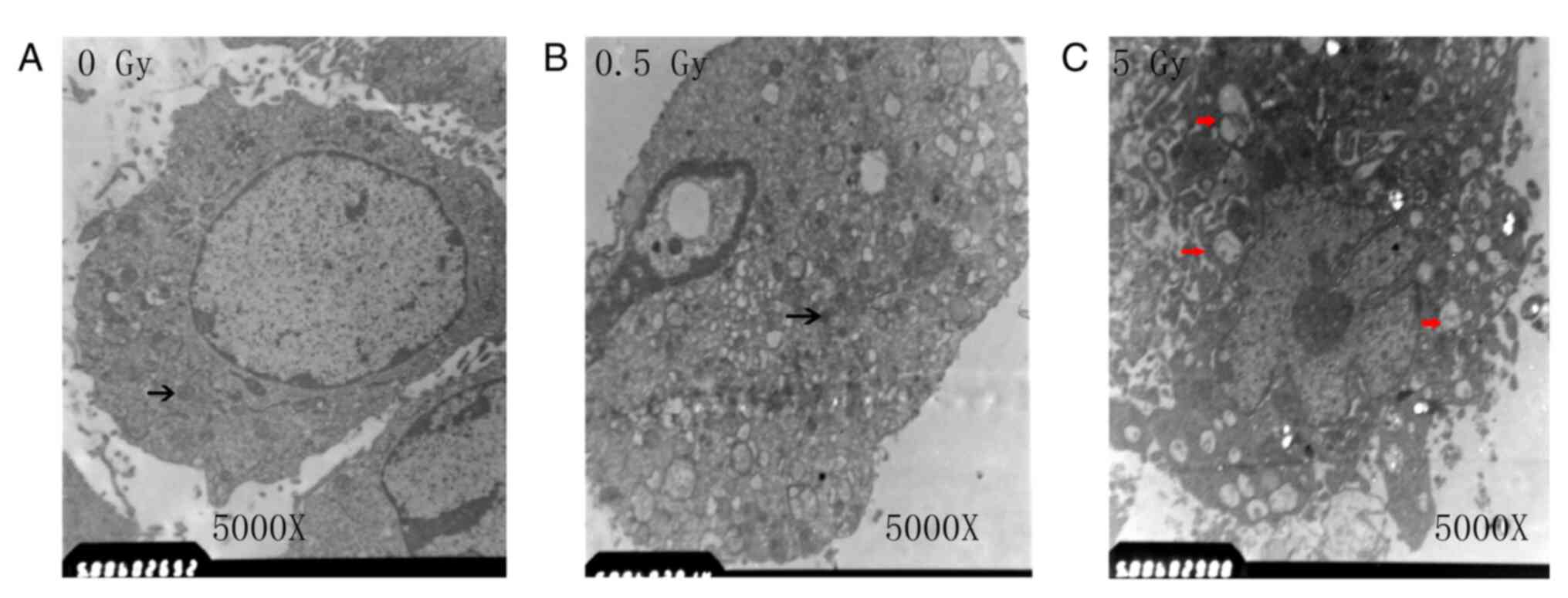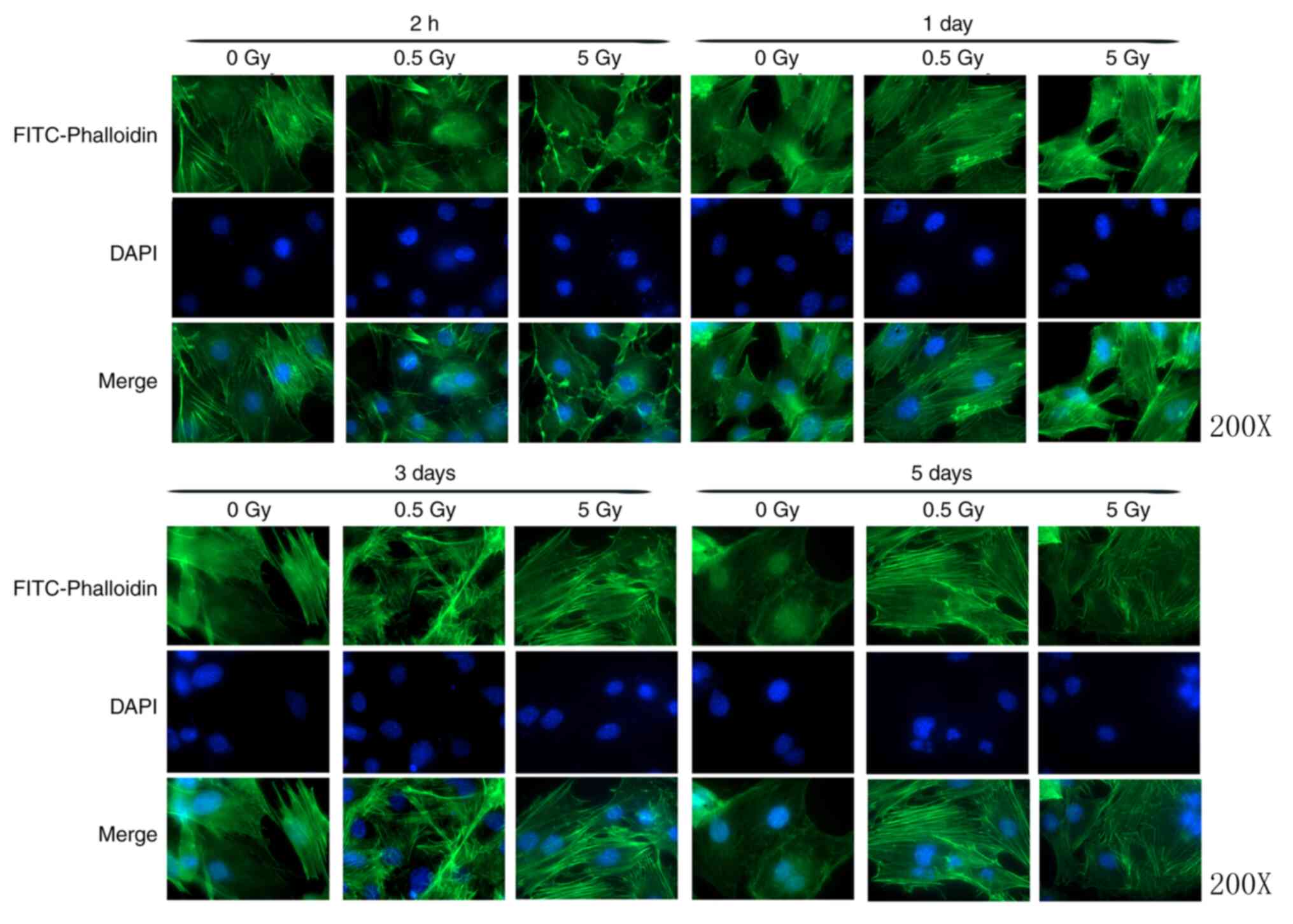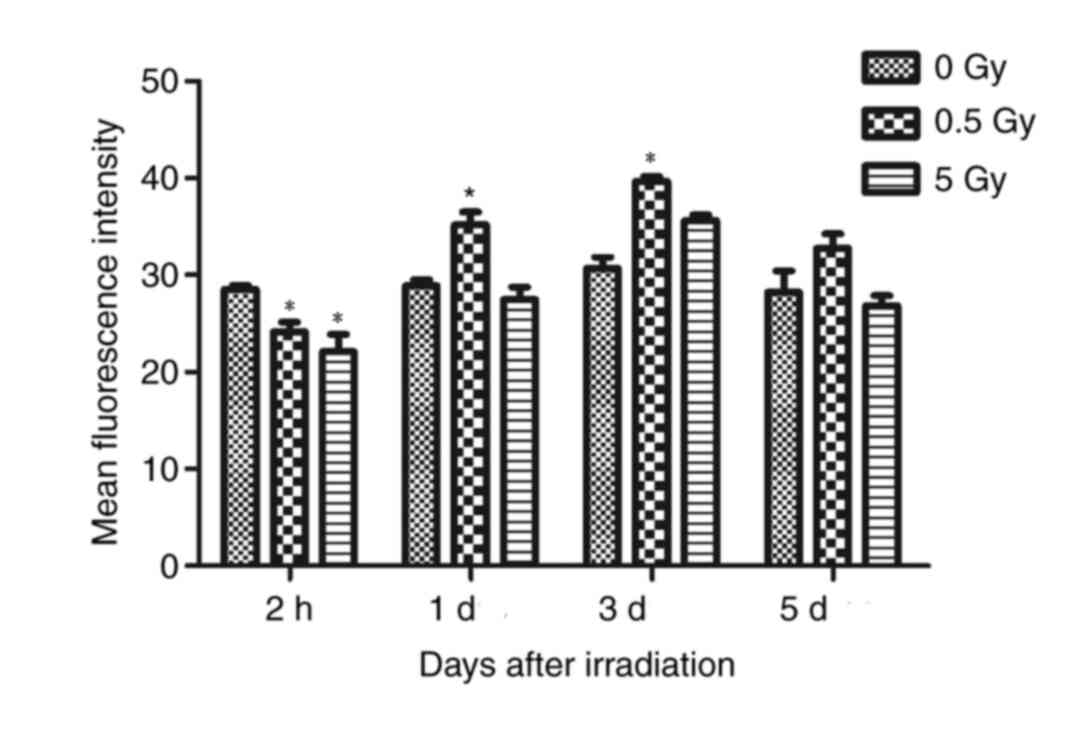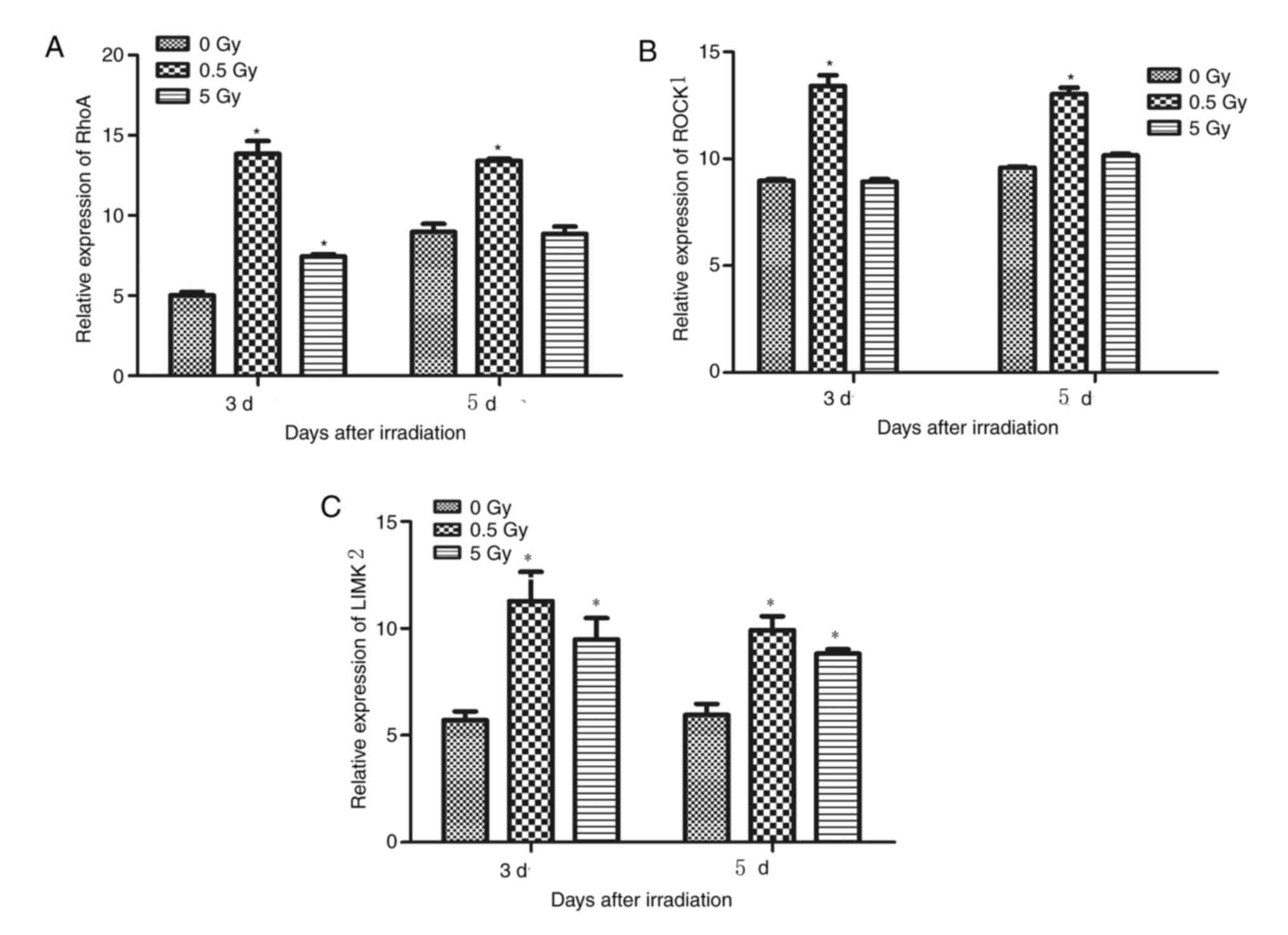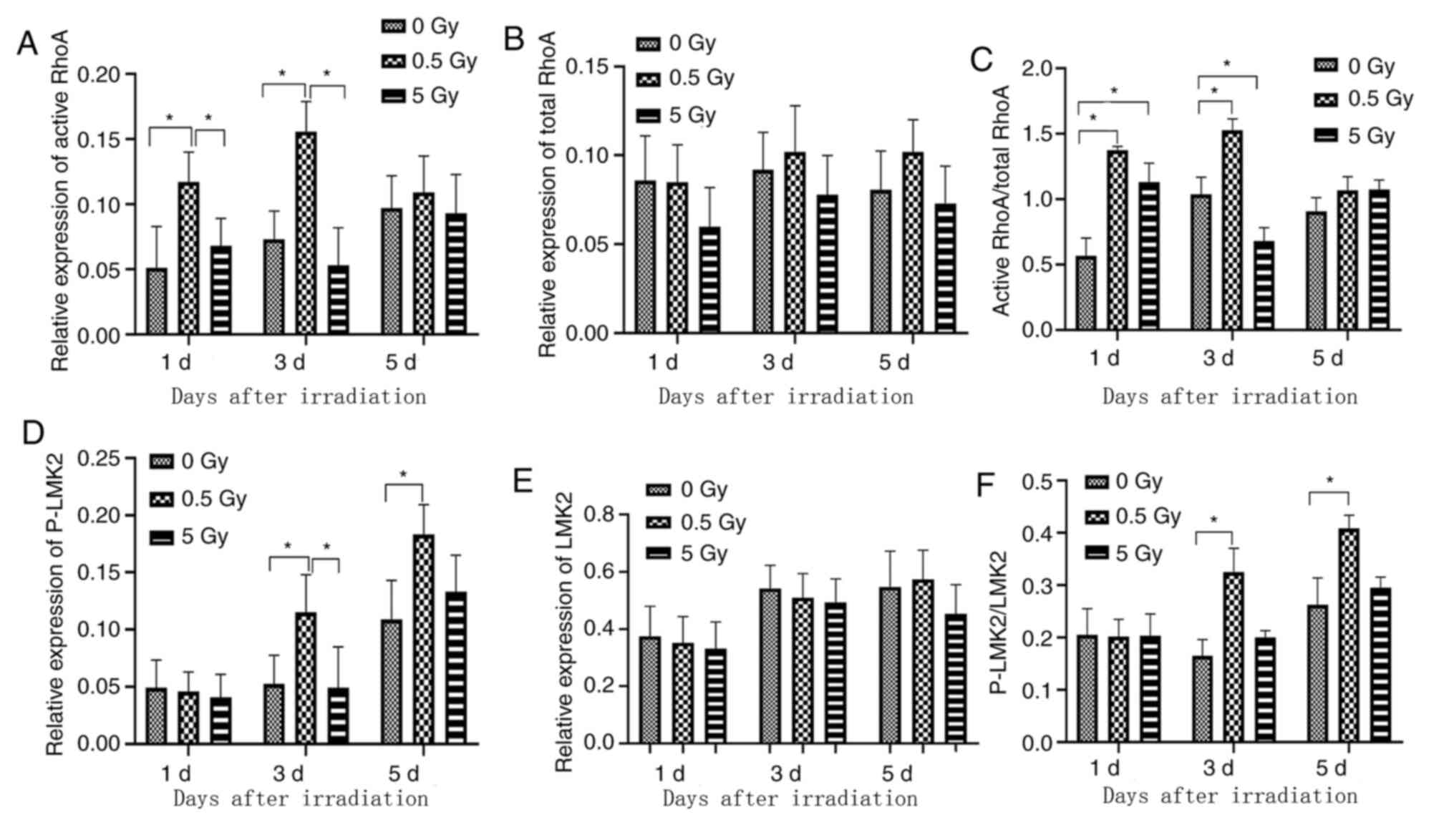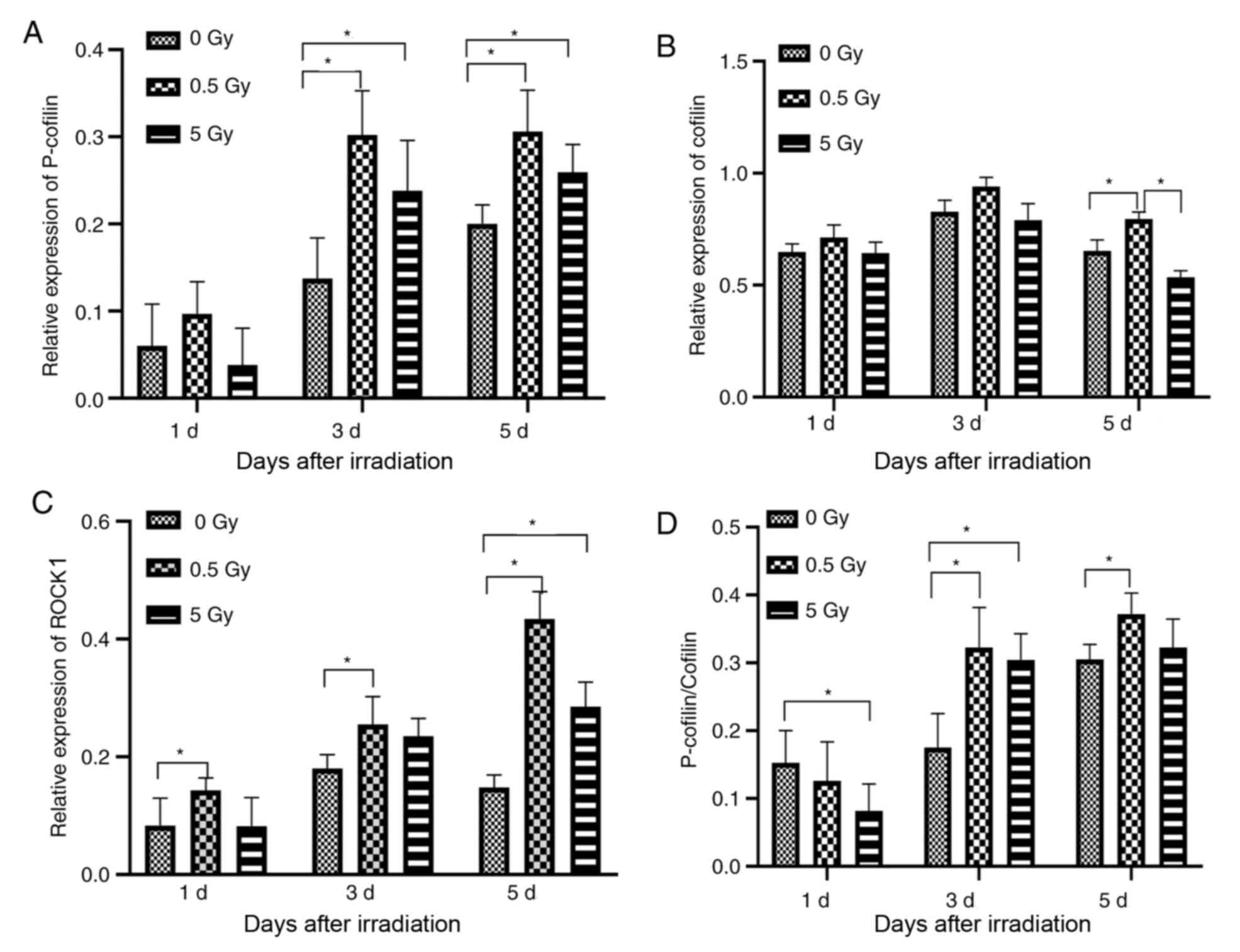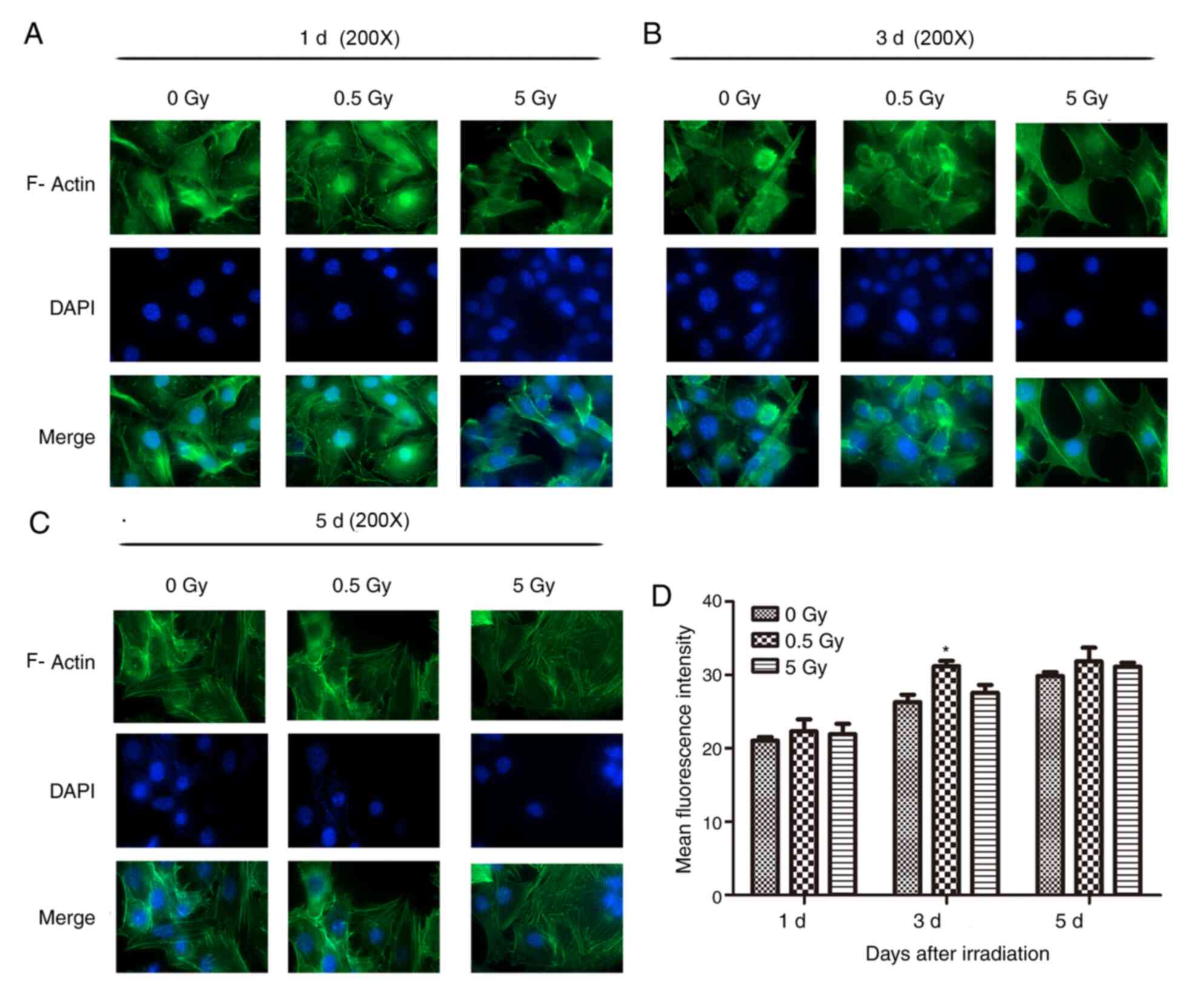|
1
|
Fazel R, Krumholz HM, Wang Y, Ross JS,
Chen J, Ting HH, Shah ND, Nasir K, Einstein AJ and Nallamothu BK:
Exposure to low-dose ionizing radiation from medical imaging
procedures. N Engl J Med. 361:849–857. 2009.PubMed/NCBI View Article : Google Scholar
|
|
2
|
Oh D and Huh SJ: Insufficiency fracture
after radiation therapy. Radiat Oncol J. 32:213–220.
2014.PubMed/NCBI View Article : Google Scholar
|
|
3
|
Michel G, Blery P, Pilet P, Guicheux J,
Weiss P, Malard O and Espitalier F: Micro-CT analysis of
radiation-induced osteopenia and bone hypovascularization in Rat.
Calcif Tissue Int. 97:62–68. 2015.PubMed/NCBI View Article : Google Scholar
|
|
4
|
Wei RL, Jung BC, Manzano W, Sehgal V,
Klempner SJ, Lee SP, Ramsinghani NS and Lall C: Bone mineral
density loss in thoracic and lumbar vertebrae following radiation
for abdominal cancers. Radiother Oncol. 118:430–436.
2016.PubMed/NCBI View Article : Google Scholar
|
|
5
|
Oest ME, Mann KA, Zimmerman ND and Damron
TA: Parathyroid hormone (1-34) transiently protects against
radiation-induced bone fragility. Calcif Tissue Int. 98:619–630.
2016.PubMed/NCBI View Article : Google Scholar
|
|
6
|
Luckey T: Physiological benefits from low
levels of ionizing radiation. Health Phys. 43:771–789.
1982.PubMed/NCBI View Article : Google Scholar
|
|
7
|
Park SS, Kim KA, Lee SY, Lim SS, Jeon YM
and Lee JC: X-ray radiation at low doses stimulates differentiation
and mineralization of mouse calvarial osteoblasts. BMB Rep.
45:571–576. 2012.PubMed/NCBI View Article : Google Scholar
|
|
8
|
Zhou XZ, Zhang G, Dong QR, Chan CW, Liu CF
and Qin L: Low-dose X-irradiation promotes mineralization of
fracture callus in a rat model. Arch Orthop Trauma Surg.
129:125–132. 2009.PubMed/NCBI View Article : Google Scholar
|
|
9
|
Schlessinger K, Hall A and Tolwinski N:
Wnt signaling pathways meet Rho GTPases. Genes Dev. 23:265–277.
2009.PubMed/NCBI View Article : Google Scholar
|
|
10
|
Theocharopoulos N, Perisinakis K,
Damilakis J, Papadokostakis G, Hadjipavlou A and Gourtsoyiannis N:
Occupational exposure from common fluoroscopic projections used in
orthopaedic surgery. J Bone Joint Surg Am. 85:1698–1703.
2003.PubMed/NCBI View Article : Google Scholar
|
|
11
|
Pramojanee SN, Pratchayasakul W,
Chattipakorn N and Chattipakorn SC: Low-dose dental irradiation
decreases oxidative stress in osteoblastic MC3T3-E1 cells without
any changes in cell viability, cellular proliferation and cellular
apoptosis. Arch Oral Biol. 57:252–256. 2012.PubMed/NCBI View Article : Google Scholar
|
|
12
|
Xu W, Xu L, Chen M, Mao YT, Xie ZG, Wu SL
and Dong QR: The effects of low dose X-irradiation on osteoblastic
MC3T3-E1 cells in vitro. BMC Musculoskelet Disord.
13(94)2012.PubMed/NCBI View Article : Google Scholar
|
|
13
|
Chen M, Huang Q, Xu W, She C, Xie ZG, Mao
YT, Dong QR and Ling M: Low-dose X-ray irradiation promotes
osteoblast proliferation, differentiation and fracture healing.
PLoS One. 9(e104016)2014.PubMed/NCBI View Article : Google Scholar
|
|
14
|
Murata K, Noda SE, Oike T, Takahashi A,
Yoshida Y, Suzuki Y, Ohno T, Funayama T, Kobayashi Y, Takahashi T
and Nakano T: Increase in cell motility by carbon ion irradiation
via the Rho signaling pathway and its inhibition by the ROCK
inhibitor Y-27632 in lung adenocarcinoma A549 cells. J Radiat Res.
55:658–664. 2014.PubMed/NCBI View Article : Google Scholar
|
|
15
|
Chen M, Dong QR, Huang Q, Xu W and She C:
Effects of 0.5 Gy X-ray radiation on the profile of gene expression
in MC3T3-E1 osteoblasts. Zhonghua Yi Xue Za Zhi. 96:2659–2664.
2016.PubMed/NCBI View Article : Google Scholar : (In Chinese).
|
|
16
|
Kawano T, Zhu M, Troiano N, Horowitz M,
Bian J, Gundberg C, Kolodziejczak K and Insogna K: LIM kinase 1
deficient mice have reduced bone mass. Bone. 52:70–82.
2013.PubMed/NCBI View Article : Google Scholar
|
|
17
|
Szezerbaty SKF, de Oliveira RF,
Pires-Oliveira DAA, Soares CP, Sartori D and Poli-Frederico RC: The
effect of low-level laser therapy (660 nm) on the gene expression
involved in tissue repair. Lasers Med Sci. 33:315–321.
2018.PubMed/NCBI View Article : Google Scholar
|
|
18
|
Kurpinski K, Jang DJ, Bhattacharya S,
Rydberg B, Chu J, So J, Wyrobek A, Li S and Wang D: Differential
effects of x-rays and high-energy 56Fe ions on human mesenchymal
stem cells. Int J Radiat Oncol Biol Phys. 73:869–877.
2009.PubMed/NCBI View Article : Google Scholar
|
|
19
|
Li X, Liu C, Li P, Li S, Zhao Z, Chen Y,
Huo B and Zhang D: Connexin 43 is a potential regulator in fluid
shear stress-induced signal transduction in osteocytes. J Orthop
Res. 31:1959–1965. 2013.PubMed/NCBI View Article : Google Scholar
|
|
20
|
Moorer MC and Stains JP: Connexin43 and
the intercellular signaling network regulating skeletal remodeling.
Curr Osteoporos Rep. 15:24–31. 2017.PubMed/NCBI View Article : Google Scholar
|
|
21
|
Gotlieb AI: The endothelial cytoskeleton:
Organization in normal and regenerating endothelium. Toxicol
Pathol. 18:603–617. 1990.PubMed/NCBI
|
|
22
|
McBeath R, Pirone DM, Nelson CM,
Bhadriraju K and Chen CS: Cell shape, cytoskeletal tension, and
RhoA regulate stem cell lineage commitment. Dev Cell. 6:483–495.
2004.PubMed/NCBI View Article : Google Scholar
|
|
23
|
Ricci R, Pazos MC, Borges RE and
Pacheco-Soares C: Biomodulation with low-level laser radiation
induces changes in endothelial cell actin filaments and
cytoskeletal organization. J Photochem Photobiol B. 95:6–8.
2009.PubMed/NCBI View Article : Google Scholar
|
|
24
|
Tani A, Chellini F, Giannelli M, Nosi D,
Zecchi-Orlandini S and Sassoli C: Red (635 nm), Near-infrared (808
nm) and Violet-Blue (405 nm) photobiomodulation potentiality on
human osteoblasts and mesenchymal stromal cells: A morphological
and molecular in vitro study. Int J Mol Sci.
19(1946)2018.PubMed/NCBI View Article : Google Scholar
|
|
25
|
Zhang S, Cheng J and Qin YX:
Mechanobiological modulation of cytoskeleton and calcium influx in
osteoblastic cells by short-term focused acoustic radiation force.
PLoS One. 7(e38343)2012.PubMed/NCBI View Article : Google Scholar
|
|
26
|
Arnsdorf EJ, Tummala P, Kwon RY and Jacobs
CR: Mechanically induced osteogenic differentiation-the role of
RhoA, ROCKII and cytoskeletal dynamics. J Cell Sci. 122:546–553.
2009.PubMed/NCBI View Article : Google Scholar
|
|
27
|
Kempf SJ, Buratovic S, von Toerne C,
Moertl S, Stenerlöw B, Hauck SM, Atkinson MJ, Eriksson P and Tapio
S: Ionising radiation immediately impairs synaptic
plasticity-associated cytoskeletal signalling pathways in HT22
cells and in mouse brain: An in vitro/in vivo comparison study.
PLoS One. 9(e110464)2014.PubMed/NCBI View Article : Google Scholar
|
|
28
|
Onoda JM, Kantak SS and Diglio CA:
Radiation induced endothelial cell retraction in vitro: Correlation
with acute pulmonary edema. Pathol Oncol Res. 5:49–55.
1999.PubMed/NCBI View Article : Google Scholar
|
|
29
|
Wang S, Chen C, Su K, Zha D, Liang W,
Hillebrands JL, Goor Hv and Ding G: Angiotensin II induces
reorganization of the actin cytoskeleton and myosin light-chain
phosphorylation in podocytes through rho/ROCK-signaling pathway.
Ren Fail. 38:268–275. 2016.PubMed/NCBI View Article : Google Scholar
|
|
30
|
Etienne-Manneville S and Hall A: Rho
GTPases in cell biology. Nature. 420:629–635. 2002.PubMed/NCBI View Article : Google Scholar
|
|
31
|
Amano M, Nakayama M and Kaibuchi K:
Rho-kinase/ROCK: A key regulator of the cytoskeleton and cell
polarity. Cytoskeleton (Hoboken, NJ). 67:545–554. 2010.PubMed/NCBI View Article : Google Scholar
|
|
32
|
Tang AT, Campbell WB and Nithipatikom K:
ROCK1 feedback regulation of the upstream small GTPase RhoA. Cell
Signal. 24:1375–1380. 2012.PubMed/NCBI View Article : Google Scholar
|
|
33
|
Carlier MF and Pantaloni D: Control of
actin assembly dynamics in cell motility. J Biol Chem.
282:23005–23009. 2007.PubMed/NCBI View Article : Google Scholar
|
|
34
|
Livak KJ and Schmittgen TD: Analysis of
relative gene expression data using real-time quantitative PCR and
the 2(-Delta Delta C(T)) method. Method. 25:402–408.
2001.PubMed/NCBI View Article : Google Scholar
|
|
35
|
Vardouli L, Moustakas A and Stournaras C:
LIM-kinase 2 and cofilin phosphorylation mediate actin cytoskeleton
reorganization induced by transforming growth factor-beta. J Biol
Chem. 280:11448–11457. 2005.PubMed/NCBI View Article : Google Scholar
|
|
36
|
Zeng X, Feng Q, Zhao F, Sun C, Zhou T,
Yang J and Zhan X: Puerarin inhibits TRPM3/miR-204 to promote
MC3T3-E1 cells proliferation, differentiation and mineralization.
Phytother Res. 32:996–1003. 2018.PubMed/NCBI View Article : Google Scholar
|
|
37
|
Pollard TD and Goldman RD: Overview of the
cytoskeleton from an evolutionary perspective. Cold Spring Harb
Perspect Biol. 10(a030288)2018.PubMed/NCBI View Article : Google Scholar
|
|
38
|
Blanquie O and Bradke F: Cytoskeleton
dynamics in axon regeneration. Curr Opin Neurobiol. 51:60–69.
2018.PubMed/NCBI View Article : Google Scholar
|
|
39
|
Wang Y, Shan Q, Pan J and Yi S: Actin
cytoskeleton affects schwann cell migration and peripheral nerve
regeneration. Front Physiol. 9(23)2018.PubMed/NCBI View Article : Google Scholar
|
|
40
|
Szymanski D and Staiger CJ: The actin
cytoskeleton: Functional arrays for cytoplasmic organization and
cell shape control. Plant Physiol. 176:106–118. 2018.PubMed/NCBI View Article : Google Scholar
|
|
41
|
Galli C, Piemontese M, Lumetti S,
Ravanetti F, Macaluso GM and Passeri GJ: Actin cytoskeleton
controls activation of Wnt/β-catenin signaling in mesenchymal cells
on implant surfaces with different topographies. Acta Biomater.
8:2963–2968. 2012.PubMed/NCBI View Article : Google Scholar
|
|
42
|
Panzetta V, De Menna M, Musella I,
Pugliese M, Quarto M, Netti PA and Fusco S: X-rays effects on
cytoskeleton mechanics of healthy and tumor cells. Cytoskeleton
(Hoboken, NJ). 74:40–52. 2017.PubMed/NCBI View Article : Google Scholar
|
|
43
|
Mohammadkarim A, Tabatabaei M, Parandakh
A, Mokhtari-Dizaji M, Tafazzoli-Shadpour M and Khani MM: Radiation
therapy affects the mechanical behavior of human umbilical vein
endothelial cells. J Mech Behav Biomed Mater. 85:188–193.
2018.PubMed/NCBI View Article : Google Scholar
|
|
44
|
Savla U and Waters CM: Barrier function of
airway epithelium: Effects of radiation and protection by
keratinocyte growth factor. Radiat Res. 150:195–203.
1998.PubMed/NCBI
|
|
45
|
Rousseau M, Gaugler MH, Rodallec A,
Bonnaud S, Paris F and Corre I: RhoA GTPase regulates
radiation-induced alterations in endothelial cell adhesion and
migration. Biochem Biophys Res Commun. 414:750–755. 2011.PubMed/NCBI View Article : Google Scholar
|
|
46
|
Gabryś D, Greco O, Patel G, Prise KM,
Tozer GM and Kanthou C: Radiation effects on the cytoskeleton of
endothelial cells and endothelial monolayer permeability. Int J
Radiat Oncol Biol Phys. 69:1553–1562. 2007.PubMed/NCBI View Article : Google Scholar
|
|
47
|
Speidel MT, Holmquist B, Kassis AI, Humm
JL, Berman RM, Atcher RW, Hines JJ and Macklis RM: Morphological,
biochemical, and molecular changes in endothelial cells after
alpha-particle irradiation. Radiat Res. 136:373–381.
1993.PubMed/NCBI
|
|
48
|
Kantak SS, Diglio CA and Onoda JM: Low
dose radiation-induced endothelial cell retraction. Int J Radiat
Biol. 64:319–328. 1993.PubMed/NCBI View Article : Google Scholar
|
|
49
|
Seo CH, Jeong H, Feng Y, Montagne K,
Ushida T, Suzuki Y and Furukawa KS: Micropit surfaces designed for
accelerating osteogenic differentiation of murine mesenchymal stem
cells via enhancing focal adhesion and actin polymerization.
Biomaterials. 35:2245–2252. 2014.PubMed/NCBI View Article : Google Scholar
|
|
50
|
Cao X, Wu X, Frassica D, Yu B, Pang L,
Xian L, Wan M, Lei W, Armour M, Tryggestad E, et al: Irradiation
induces bone injury by damaging bone marrow microenvironment for
stem cells. Proc Natl Acad Sci USA. 108:1609–1614. 2011.PubMed/NCBI View Article : Google Scholar
|
|
51
|
Rodrigues-Moreira S, Moreno SG, Ghinatti
G, Lewandowski D, Hoffschir F, Ferri F, Gallouet AS, Gay D,
Motohashi H, Yamamoto M, et al: Low-dose irradiation promotes
persistent oxidative stress and decreases self-renewal in
hematopoietic stem cells. Cell Rep. 20:3199–3211. 2017.PubMed/NCBI View Article : Google Scholar
|
|
52
|
Wang C, Blough E, Dai X, Olajide O,
Driscoll H, Leidy JW, July M, Triest WE and Wu M: Protective
effects of cerium oxide nanoparticles on MC3T3-E1 osteoblastic
cells exposed to X-ray irradiation. Cell Physiol Biochem.
38:1510–1519. 2016.PubMed/NCBI View Article : Google Scholar
|
|
53
|
Chu S, Mao X, Guo H, Wang L, Li Z, Zhang
Y, Wang Y, Wang H, Zhang X and Peng W: Indoxyl sulfate potentiates
endothelial dysfunction via reciprocal role for reactive oxygen
species and RhoA/ROCK signaling in 5/6 nephrectomized rats. Free
Radic Res. 51:237–252. 2017.PubMed/NCBI View Article : Google Scholar
|
|
54
|
Luo J, Li D, Wei D, Wang X, Wang L and
Zeng X: RhoA and RhoC are involved in stromal cell-derived
factor-1-induced cell migration by regulating F-actin
redistribution and assembly. Mol Cell Biochem. 436:13–21.
2017.PubMed/NCBI View Article : Google Scholar
|
|
55
|
Aghajanian A, Wittchen ES, Campbell SL and
Burridge K: Direct activation of RhoA by reactive oxygen species
requires a redox-sensitive motif. PLoS One. 4(e8045)2009.PubMed/NCBI View Article : Google Scholar
|
|
56
|
Truman JP, García-Barros M, Kaag M,
Hambardzumyan D, Stancevic B, Chan M, Fuks Z, Kolesnick R and
Haimovitz-Friedman A: Endothelial membrane remodeling is obligate
for anti-angiogenic radiosensitization during tumor radiosurgery.
PLoS One. 5(e12310)2010.PubMed/NCBI View Article : Google Scholar
|
|
57
|
Shi F, Wang YC, Hu ZB, Xu HY, Sun J, Gao
Y, Li XT, Yang CB, Xie C, Li CF, et al: Simulated microgravity
promotes angiogenesis through RhoA-dependent rearrangement of the
actin cytoskeleton. Cell Physiol Biochem. 41:227–238.
2017.PubMed/NCBI View Article : Google Scholar
|
|
58
|
Torroba B, Herrera A, Menendez A and Pons
S: PI3K regulates intraepithelial cell positioning through Rho
GTP-ases in the developing neural tube. Dev Biol. 436:42–54.
2018.PubMed/NCBI View Article : Google Scholar
|
















